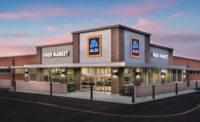
Boost Snack Sales Through Merchandising
By Chris Clark,
SFA V.P. of Membership and Administration
SFA V.P. of Membership and Administration
Editor’s note: For the first time, the Snack Food Association (SFA) co-sponsored the REAL DEAL EXPO, sponsored by the American Wholesale Marketers Association (AWMA). The expo is the only show devoted exclusively to warehouse-distributed snack foods, confections, general merchandise and other convenience products.
There is a huge opportunity to boost single-serve snack sales, according to a new study by Masterfoods USA and the William Wrigley Jr. Company. Speaking at the REAL DEAL EXPO, held Feb. 23-25, 2005, in Las Vegas, Nev., Linda Lieberman, senior director of sales planning for the convenience and drug channels at Masterfoods, stressed that there is an opportunity for convenience stores to generate $1 billion more in confectionery sales simply by using off-shelf merchandising and endcaps for candy and gum products.
“Only two out of 10 consumers go down the confectionery aisle in the convenience store,” she said. “These are impulse items. So if you can get more people to use off-shelf merchandising on endcaps, for the entire industry that’s $1 billion.”
Lieberman said top-performing stores have at least three or four off-shelf merchandising locations outside of the confectionery aisle. Noting that convenience store sales have been flat, Lieberman said a big problem is that cigarette sales are down, and many consumers now pay for their gas at the pump and have no reason to go inside the store. Thus, she advised the use of merchandising vehicles at gas pumps to encourage pay-at-the-pump customers to enter the store. She said the study found that single-serve snacks generate almost $14 billion in annual sales, representing 7.3% of total in-store sales.
Confectionery and salty snacks account for about 59% of dollar sales of single-serve snacks through the c-store channel, and confectionery alone accounts for almost 43% of single-serve snacks profits.
“Because of the impulse nature of single-serve snacks, they provide a huge opportunity to c-store operators to expand the consumer shopping basket,” Lieberman said.
The Masterfoods study shows that the average c-store shopper makes 1.9 stops during a shopping trip, including the checkout counter. When asked which areas they shopped, 43% mentioned the checkout counter and 40% mentioned the beverage cooler. Only 22% said they shopped the confectionery aisle, and 20% cited the snack aisle.
“Because consumers do not shop all sections of the c-store, it is important to merchandise items that can provide complementary purchases at these destination locations,” Lieberman said. She added that sales improve when salty snacks and confectionery products are also sold in the food service area.
“If the consumer is not going to shop the whole store, then retailers must merchandise high-impulse items in the areas of the store that consumers do shop,” she explained.
Distribution Through Warehouses
Although direct-store-delivery (DSD) operations are a cornerstone to the snack food industry, some snack food manufacturers are looking at warehouse distribution as an additional way to get more product to more retail outlets. Meanwhile, manufacturers who use independent distributors are looking for ways to increase efficiency and profitability of their products, suggested Kit Dietz, president of Dietz Consulting.
The AWMA-sponsored “Warehouse Delivered Snacks” program is comprised of AWMA distributor members, snack food manufacturers and retail operators. Recognizing that the cigarette category continues to decline, the “Warehouse Delivered Snacks” program is looking to increasing profitability of other categories (such as savory snacks and confectionery products) by encouraging retailers and distributors to work together to develop and build better in-store displays, such as multi-vendor endcaps (MVE).
“These products could be on display for 60 to 90 days, as determined by the retailer and by the success of the product. The goal is to rotate new products and keep generating consumer interest and excitement,” said Dietz. “Let’s face it, cigarette volume continues to decline, which is a huge hit to the bottom line. We need to grow profitable categories outside of cigarettes, and the multi-vendor endcap is a great way to do this.”
A number of SFA members participated, including Herr Foods, Inc.; Pretzels, Incorporated; Tom’s Foods; The Procter & Gamble Co.; Rudolph Foods Co., Inc. and Jack Link’s Beef Jerky.
The 2004 AWMA REAL DEAL EXPO concluded Friday, Feb. 25 in Las Vegas. For more information, please contact Christopher Clark at 703-836-4500 ext. 218, or by email at cclark@sfa.org.
PRESIDENT’S LETTER
On the Whole, Grains Are Back!!!
Dear SFA Members,
Thanks in part to the recent release of the U.S. Dietary Guidelines, which emphasized the importance of whole grains in the diet, grains are back into the mainstream of Americans’ dietary choices. You can’t turn on the television or open a magazine now without encountering an advertisement for a product rich in whole grains. Of course, grains of every kind had been given a black eye during the last few years because grains are carbohydrates, and many consumers assumed that all carbohydrates were bad for you, as Atkins and other diets proclaimed.
The snack food industry is well-positioned to take advantage of the frenzy over whole grains, as many of our products can incorporate whole grains easily and promote them as a healthier alternative. At present, popcorn and some varieties of pretzels, corn snacks, tortilla chips, crackers and snack bars include whole grains.
Although many snack companies and snack technology consultants are developing snacks that include whole grains, some in our industry have been slow to follow this trend. In order to assist members interested in developing whole-grain
products and to understand grain-based foods in general, SFA has developed an entirely new focus for our traditional Pretzel Seminar. For one, we are now calling it the Pretzel and Baked Snack Seminar. Additionally, we have moved the seminar from November to April, to hold it at a time of year when baking operations traditionally slow down a bit. And, we are holding the seminar at Penn State University (PSU) to take advantage of the excellent food science department at this world-class university. In addition to whole grains, topics will include trends in functional foods for the baking industry, baking technology and quality assurance specifically for baking, including advances in the SFA-backed dough crystallization research at PSU.
Recognizing that baked products are coming back into popularity quickly with consumers, the SFA Pretzel and Baked Snacks Seminar at Penn State University should be on your calendar for Apr. 6-7. I look forward to seeing you there.
Sincerely,
James A. McCarthy
President & CEO



